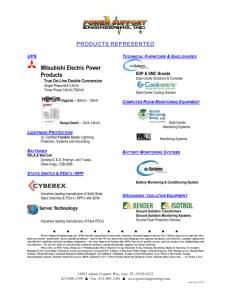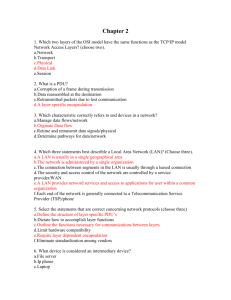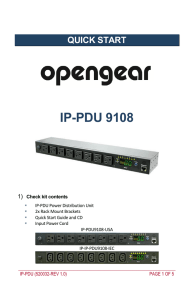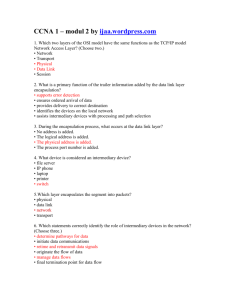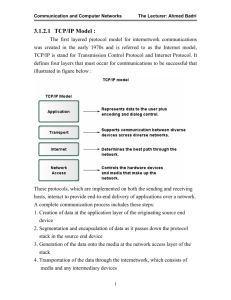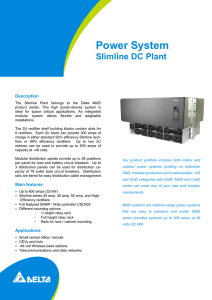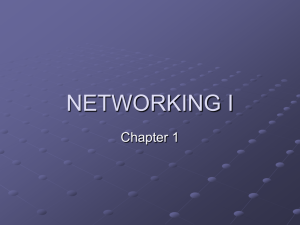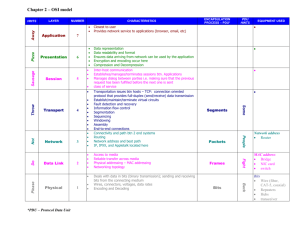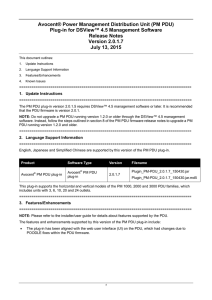CCNA_Exploration1_Chapter2
advertisement
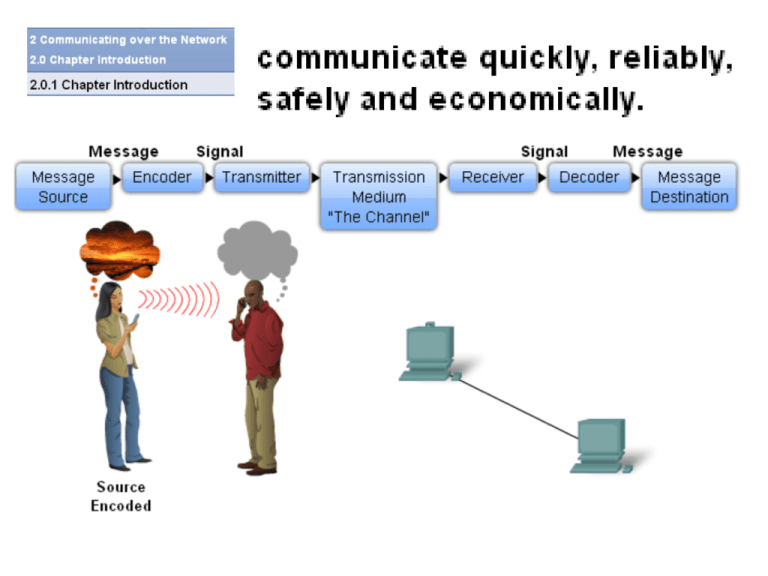
First, by sending smaller individual pieces from source to destination, many different conversations can be interleaved on the network. The process used to interleave the pieces of separate conversations together on the network is called multiplexing. Second, segmentation can increase the reliability of network communications. The separate pieces of each message need not travel the same pathway across the network from source to destination. If a particular path becomes congested with data traffic or fails, individual pieces of the message can still be directed to the destination using alternate pathways. Some examples of end devices are: Computers (work stations, laptops, file servers, web servers) Network printers VoIP phones Security cameras Mobile handheld devices (such as wireless barcode scanners, PDAs) In the context of a network, end devices are referred to as hosts. intermediary network devices are: Network Access Devices (Hubs, switches, and wireless access points) Internetworking Devices (routers) Communication Servers and Modems Security Devices (firewalls) intermediary network devices perform these functions: Regenerate and retransmit data signals Maintain information about what pathways exist through the network Notify other devices of errors and communication failures Direct data along alternate pathways when there is a link failure Classify and direct messages according to QoS priorities Permit or deny the flow of data, based on security settings telecommunications service provider (TSP) The Internet is created by the interconnection of networks belonging to Internet Service Providers (ISPs). The following terms may be interchangeable: internetwork, data network, and network. The term intranet is often used to refer to a private connection of LANs and WANs that belongs to an organization, and is designed to be accessible only by the organization's members, employees, or others with authorization. Network Interface Card - A NIC, or LAN adapter, provides the physical connection to the network at the PC or other host device. The media connecting the PC to the networking device plugs directly into the NIC. Physical Port - A connector or outlet on a networking device where the media is connected to a host or other networking device. Interface - Specialized ports on an internetworking device that connect to individual networks. Because routers are used to interconnect networks, the ports on a router are referred to network interfaces. The RFCs also contain technical and organizational documents about the Internet, including the technical specifications and policy documents produced by the Internet Engineering Task Force (IETF) Frame Trailer Data - The general term for the PDU used at the Application layer Segment - Transport Layer PDU Packet - Internetwork Layer PDU Frame - Network Access Layer PDU Bits - A PDU used when physically transmitting data over the medium The first identifier, the host physical address, is contained in the header of the Layer 2 PDU, called a frame. Layer 2 is concerned with the delivery of messages on a single local network. The Layer 2 address is unique on the local network and represents the address of the end device on the physical media. In a LAN using Ethernet, this address is called the Media Access Control (MAC) address. Straight-through Cable: Unshielded twisted pair (UTP) copper cable for connecting dissimilar networking devices Crossover Cable: UTP copper cable for connecting similar networking devices Serial Cable: Copper cable typical of wide area connections Ethernet: Dominant local area network technology MAC Address: Ethernet Layer 2, physical address IP Address: Layer 3 logical address Subnet Mask: Required to interpret the IP address Default Gateway: The IP address on a router interface to which a network sends traffic leaving the local network NIC: Network Interface Card, the port or interface that allows an end device to participate in a network Port (hardware): An interface that allows a networking device to participate in network and to be connected via networking media Port (software): Layer 4 protocol address in the TCP/IP suite Interface (hardware): A port Interface (software): A logical interaction point within software PC: End device Computer: End device Workstation: End device Switch: Intermediate device which makes decision on frames based on Layer 2 addresses (typical Ethernet MAC addresses) Router: Layer 3, 2, and 1 device which makes decisions on packets based on Layer 3 addresses (typically IPv4 addresses) Bit: Binary digit, logical 1 or zero, has various physical representations as electrical, optical, or microwave pulses; Layer 1 PDU Frame: Layer 2 PDU Packet: Layer 3 PDU What are the key functions of encapsulation? - identifies pieces of data as part of the same communication - ensures that data pieces can be directed to the correct receiving end device - enables the reassembly of complete messages benefits of using a layered approach to assist with network troubleshooting -Prevent technology change at one layer from affecting technology at another layer of the model -To make network communication easier to understand. -Allow competitors to design products at different layer of the model and have them work together. information travels from the source to the destination -Headers are added to uniquely identify hosts. -Protocols determine the type, structure and purpose of labels and addressing. primary functions of the header and trailer information -assist intermediary devices with processing and path selection -uniquely identifies source and destination devices -manage error recovery and data integrity data flows across the internetwork -Overhead is used to notify devices on a network that errors have been detected in data transmission. -Path selection is important for optimizing data flow and increasing performance. -Managing data flow and regulating traffic types is handled by intermediary devices. intermediary devices in the network -determine pathways for data -retime and retransmit data signals -manage data flows network protocols -define the structure of layer specific PDU's -outline the functions necessary for communications between layers -require layer dependent encapsulations
